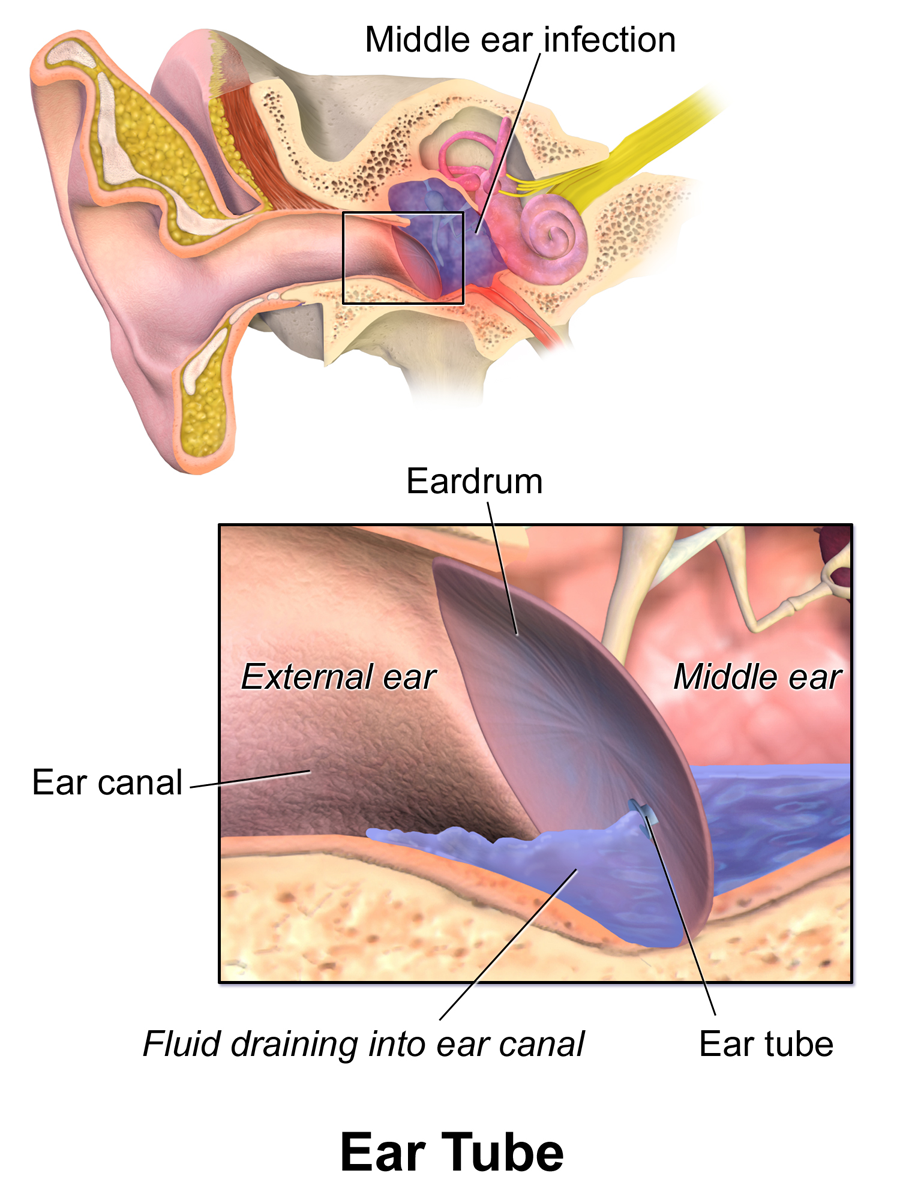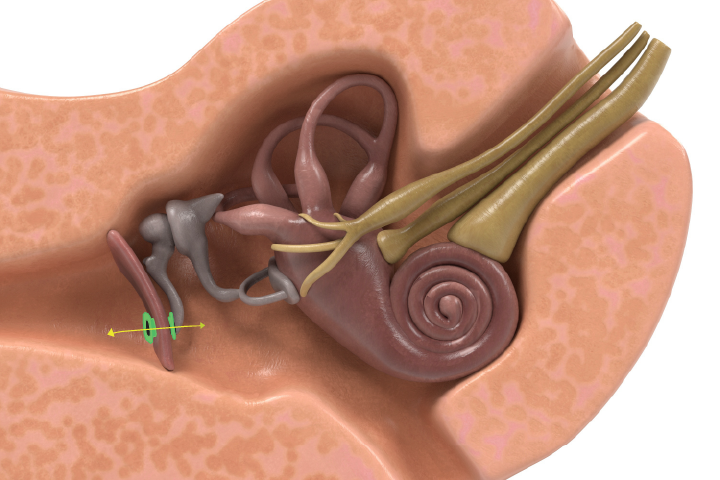Procedures: Tympanostomy Tube Placement
(also known as PNEUMATIC EQUALIZATION or “PE” TUBE placement)
This video demonstrates the creation of a hole in the eardrum, allowing fluid to drain from the middle ear and air to pass into the middle ear. Not shown is placement of a tube within this hole to keep it open.
Simple and very effective, an ear tube (also called pneumatic equalization tube, or ear ventilation tube) may be placed in a matter of minutes and work by doing the following:
Representation of a tympanostomy tube (shown in green), allowing air or fluid to pass through the opening (yellow arrow).
Allow air pressure to equalize on each side of the ear drum (not dependent on the Eustachian tube)
Allow fluid of pus from the middle ear space to drain out (which avoids the painful buildup of pressure and also makes home diagnosis of an ear infection accurate).
Allow antibiotic drops to get into the middle ear space
Technically, a small incision is made in the ear drum first, and the tube is placed in this hole to work as a grommet to keep the small hole from healing sooner than desired.
Are tubes placed in an office setting or in an operating room?
Generally, most adults can have tubes placed in the office without any sedation. In this setting, a drop of an anesthetic solution, phenol, is placed on the eardrum, causing discomfort for about 10-15 seconds. Children and adults with challenging anatomy or unable to tolerate the procedure in the office have tubes placed in the operating room with a brief general anesthetic delivered usually with a mask instead of a breathing tube.
What is recovery like after tube placement?
Recovery from the procedure is usually minimal. It is rare for someone to need more than Tylenol (acetaminophen) once or twice after the procedure. When the procedure is performed in the operating room, the effects of the brief general anesthetic may include drowsiness or imbalance for the remainder of the day.
What are some differences between types tubes?
Broadly speaking, there are two categories of tympanostomy tube types: standard and long-term. With some variation, depending on the surgeon’s preference and the products available in the operating room, the standard tubes look like a tiny barbell with an open passageway through the center. The long-term tubes, often called “T tubes,” are larger and have the shape of a T. Tympanostomy tubes are composed of a plastic or smooth silicone material or, for use in certain certain situations such as to manage biofilm formation, in titanium.
Example of a standard tympanostomy tube.
Example of a T tube, used when longer need for a tube is anticipated
Size of a standard tympanostomy tube compared to a quarter
How long do tympanostomy tubes last?
Tympanostomy tubes stay in place in the eardrum for a variable length of time. On average, the standard tympanostomy tubes last roughly one year, whereas the T tubes last several years. There are occasions when a tube of either type may be extruded well before desired, and there are occasions when a tube stays in place much longer than desired. Tube replacement may be undertaken for the former situation. In a situation when a tube remains in place and is not thought to be necessary anymore (such as with a child whose tubes were placed as a toddler but still has the tubes present at age 8 or 9), removal of the tube (with or without patching of the perforation) may be performed.
What follow-up is needed after placement of tympanostomy tubes?
After tympanostomy tube placement, a patient should have their ears examined within 3 months of the procedure, and again every six months until the tubes are known to have extruded. Examination may be undertaken sooner than these scheduled times when concern arises, such as for ear pain, drainage, or a change in hearing.
Water precautions after tube placement
Prevention of water from getting into the ear canal may be accomplished with use of earplugs. Routine use of earplugs to prevent infection is not routinely necessary. For example, a child with a new set of tympanostomy tubes may swim in a chlorinated swimming pool without earplugs and will typically not incur an infection.
Situations in which use of earplugs is advisable include the following:
When swimming in a lake or the ocean
When diving deep underwater
When dunking the head underwater in a bathtub
When non-use of earplugs has led to ear infection (as occasionally happens when swimming in a chlorinated pool or bathing even without dunking the head under water)
When a person prefers wearing earplugs (such as for those experiencing discomfort from water entry into the ear canal)
What is a biofilm?
A biofilm on tympanostomy tubes is a complex community of microorganisms that adhere to the surface of the tubes. These microorganisms are embedded in a self-produced matrix of extracellular polymeric substances, which allows them to resist antibiotics and host immune responses.
Biofilm formation may contribute to persistent infections, resulting in ongoing drainage from the ear canal. This complicates treatment, as traditional antibiotic therapies may fail to clear the infection due to the protective nature of the biofilm. A biofilm is not typically seen, but rather suspected based on ongoing ear drainage despite what would normally be adequate therapy.
A condition that presents similarly to biofilm formation is the presence of drug resistant bacteria, which also may not respond to usual therapies.
When ongoing ear drainage persists despite adequate treatment and a biofilm is suspected, another procedure to remove the old tympanostomy tubes, to wash out the ear canal, and to place new (often titanium) tubes in place of the old tubes is usually undertaken.
What are some potential complications from tympanostomy tube placement?
While it is a common and generally considered safe procedure, there are potential complications that can arise, including:
Infection: While tympanostomy tubes generally reduce the frequency, severity, duration of ear infections, they do not eliminate the possibility of infection. In about 2% of patients receiving tubes, a persistent infection related to biofilm formation may occur, leading to the need for another procedure to remove the old tube, clean the ear canal, and replace the tube, often with one made of titanium.
Persistent Ear Drum Perforation: While the placement of tubes involves making a hole in the eardrum, the hole often heals closed after the tube falls out of the ear drum. It is possible, however, that the hole in the eardrum may persist after the tube has extruded.
Tube Blockage: The tubes can become blocked by fluid or debris, resulting in loss of the benefit of tubes and possibly a return of the symptoms or conditions leading to tube placement. Blocked tubes may sometimes be unblocked with use of ear drops, but sometimes blocked tubes need to be replaced in a separate procedure.
Dislodgement: Tympanostomy tubes may fall out earlier than expected, which might necessitate tube replacement. In rare cases, a tympanostomy tube may dislodge inwards and persist as a foreign body in the middle ear space. If this happens, it may not cause any problems, but if it does cause problems such as decreased hearing or infection, it may be removed in a short surgical procedure.
Hearing Changes: While most patients experience improved hearing, some may report a mild decrease in hearing due to the tube itself affecting movement of the eardrum.
Scarring: Scarring of the eardrum may occur from the insertion of the tubes. This can be seen as a white patch on the eardrum, but very rarely causes any problems.
Cholesteatoma: In some cases, the formation of a cholesteatoma—a growth of skin cells in the middle ear—can occur as a complication of ear tube placement.
Granulation tissue: Uncommonly, a type of healing tissue called granulation tissue forms on the eardrum at the site of the tympanostomy tube. This can cause minor bleeding and occasionally block the lumen of the tube, rendering it ineffective. Granulation tissue is typically very easily and effectively treated with application of ear drops containing a steroid.
Anesthesia Risks: As with any surgical procedure, there are risks associated with anesthesia.
This page







